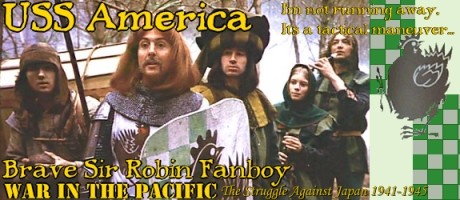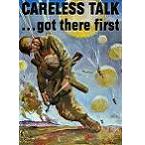Pascal_slith
Posts: 1651
Joined: 8/20/2003
From: back in Commiefornia
Status: offline

|
quote:
ORIGINAL: mike scholl 1
Actually, the truely important part is that there WAS a standard guage..., even if it was pulled straight out of someone's backside. Look at the poor Confederacy, where virtually every RR had it's own guage, and cargos had to be unloadedd and re-loaded 2, 3, or even 4 times during a long journey. Standardization was a blessing, whatever it's size.
This was one of James McPherson's points about why the North won. Standard gauge throughout the Union... And rebuilding of Southern railroads by them in each occupied territory.
Not to pour too much water on this very entertaining discussion, here is the explanation from Wikipedia, which essentially says we have some early civilization or pre-historic bureaucrat to thank for 'standard gauge'.
I quote:
Historically, the choice of gauge was partly arbitrary and partly a response to local conditions. Narrow-gauge railways are cheaper to build and can negotiate sharper curves but broad-gauge railways give greater stability and permit higher speeds.
Sometimes railway companies chose their own gauge, such as the Great Western Railway choosing 2,140 mm (7 ft 0 1⁄4 in).
Other times, statutes required railways to use a particular gauge, such as the Thomasville, Tallahassee and Gulf Railroad having to use standard gauge.
[edit] Early origins of the standard gauge
There is an urban legend that Julius Caesar specified a legal width for chariots at the width of standard gauge, causing road ruts at that width, so all later wagons had to have the same width or else risk having one set of wheels suddenly fall into one deep rut but not the other.[2][3]
In fact, the origins of the standard gauge considerably pre-date the Roman Empire, and may even pre-date the invention of the wheel. The width of prehistoric vehicles was determined by a number of interacting factors which gave rise to a fairly standard vehicle width of a little under 2 m (6.6 ft). These factors have changed little over the millennia, and are still reflected in today's motor vehicles. Road rutting was common in early roads, even with stone pavements. The initial impetus for the ruts probably came from the grooves made by sleds and slide cars dragged over the surfaces of ancient trackways. Since early carts had no steering and no brakes, negotiating hills and curves was dangerous, and cutting ruts into the stone helped them negotiate the hazardous parts of the roads.[4]
Neolithic wheeled carts found in Europe had gauges varying from 1.30 to 1.75 m (4 ft 3 in to 5 ft 9 in). By the Bronze age, wheel gauges appeared to have stabilized between 1.40 to 1.45 m (4 ft 7 in to 4 ft 9 in) which was attributed to a tradition in ancient technology which was perpetuated throughout European history.[5] The ancient Assyrians, Babylonians, Persians and Greeks constructed roads with artificial wheelruts cut in rock spaced the wheelspan of an ordinary carriage. Such ancient stone rutways connected major cities with sacred sites, such as Athens to Eleusis, Sparta to Ayklia, or Elis to Olympia. The gauge of these stone grooves was 1.38 to 1.44 m (4 ft 6 in to 4 ft 9 in). The largest number of preserved stone trackways, over 150, are found on Malta.[6]
Some of these ancient stone rutways were very ambitious. Around 600 BC the citizens of ancient Corinth constructed the Diolkos, which some consider the world's first railway, a hard poros limestone road with grooved tracks along which large wooden flatbed cars carrying ships and their cargo were pulled by slaves or draft animals. The grooves were at 1.67 m (5 ft 6 in) centres.[7]
The Roman Empire actually made less use of stone trackways than the prior Greek civilization because the Roman roads were much better than those of previous civilizations. However, there is evidence that the Romans used a more or less consistent wheel gauge adopted from the Greeks throughout Europe, and brought it to England with the Roman conquest of Britain in AD 43. After the Roman departure from Britain, this more-or-less standard gauge continued in use, so the wheel gauge of animal drawn vehicles in 19th century Britain was 1.4 to 1.5 m (4 ft 7 in to 4 ft 10 in). In 1814 George Stephenson copied the gauge of British coal wagons in his area (about 1.42 m or 4 ft 8 in) for his new locomotive, and for technical reasons widened it slightly to achieve the modern railway standard gauge of 1.435 m (4 ft 81⁄2 in).[4]
[edit] Standard gauge
Main article: Standard gauge
What became the standard gauge of 4 ft 8 1⁄2 in (1,435 mm) was chosen for the first main-line railway, the Liverpool and Manchester Railway (L&MR), by the British engineer George Stephenson; the de facto standard for the colliery railways where Stephenson had worked was 4 ft 8 in (1,422 mm). Whatever the origin of the gauge, it seemed to be a satisfactory choice: not too narrow and not too wide.
Isambard Kingdom Brunel, engineer of the Great Western Railway, chose the broader gauge of 7 ft 0 1⁄4 in (2,140 mm) because it offered greater stability and capacity at high speed. Brunel's first locomotives were exactly 7 foot gauge and had no slack, hence the extra quarter inch. The Eastern Counties Railway chose 5 ft (1,524 mm) gauge, but soon realised that lack of compatibility was a mistake and changed to Stephenson's gauge. The conflict between Brunel and Stephenson is often referred to as the Gauge War. Several non-interconnecting lines in Scotland were 5 ft 6 in (1,676 mm) but were changed to standard gauge for compatibility reasons.
In 1845 a British Royal Commission recommended adoption of 4 ft 8 1⁄2 in (1,435 mm) as standard gauge in Great Britain, 5 ft 3 in (1,600 mm) in Ireland. The following year the Parliament of the United Kingdom passed the Gauge Act, which required that new railways use the standard gauge. Except for the Great Western Railway's broad gauge, few main-line railways in Great Britain used a different gauge. The last Great Western line was converted to standard gauge in 1892.
The link is: http://en.wikipedia.org/wiki/Track_gauge#History
< Message edited by Pascal -- 9/2/2011 10:59:36 PM >
_____________________________
So much WitP and so little time to play.... :-(  |
 Printable Version
Printable Version






 [/URL][/image]
[/URL][/image]

























 New Messages
New Messages No New Messages
No New Messages Hot Topic w/ New Messages
Hot Topic w/ New Messages Hot Topic w/o New Messages
Hot Topic w/o New Messages Locked w/ New Messages
Locked w/ New Messages Locked w/o New Messages
Locked w/o New Messages Post New Thread
Post New Thread